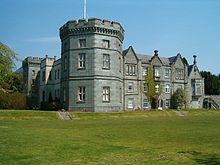Kilmory Castle (Argyll)
Kilmory Castle , also Kilmory House , is a large country house just south of Lochgilphead in the Scottish county of Argyll (now the administrative division of Argyll and Bute ). The 19th century house now houses the administration of Argyll and Bute. The gardens are open to the public and form part of the landscape park on the former estate. Historic Scotland has listed Kilmory Castle as a Category B Historic Building.
history
There was a church at Kilmory in earlier times, and in the 1550s that church and the surrounding lands belonged to the Abbot of Paisley Abbey . In 1575 the property belonged to Donald Campbell of Kilmory and remained in the hands of the Campbell family for over 250 years. There is said to have been a house on the property as early as the 14th century. The Campbells had a house built there in 1816–1820 or an existing house expanded. Eliza Campbell , the eldest daughter and co-heiress of Peter Campbell , married Sir John Orde, 2nd Baronet , in 1824 . He bought the property after the death of his father-in-law in 1828 and his wife in 1829. Orde had the old, modest Campbells house demolished in 1829–1830 and replaced it with a large country house in neo-Gothic style based on the plans of the architect Joseph Gordon Davis . The core of the old house was preserved, but expanded to an L-shaped floor plan with an octagonal tower on the southwest corner. The exterior facade and interior have been redesigned. Orde also expanded the park and in 1830 had the gardens rebuilt by William Hooker . More extensions were added in the 1863.
In 1878 Orde was buried in his private cemetery next to the house. His son inherited the title of baronet and changed his name to Campbell-Orde in 1880 . The Baronets Campbell-Orde kept the property until 1938. After that, it passed through different hands and was used as a hotel, youth hostel and conference center.
In March 1949 it was announced that Kilmory Castle would open as a national holiday center for young people in June.
In July 1971, Kilmory Castle was designated a Category B Historic Structure.
In 1974 the County Council of Argyll bought the house to house the administration of the Council Area Argyll and Bute formed in 1975. In 1995 the local government was reorganized again, but Kilmory Castle continued to serve as the administrative seat of the new Argyll and Bute Council Area . An office block was added in 1980–1982 to increase the available space. In 1983 the main house was damaged by fire, so that a large part of the interior had to be renewed.
Ghosts
The country house is said to be haunted by the spirit of the "Green Lady".
Individual evidence
- ↑ a b c d Listed Building - Entry . In: Historic Scotland .
- ^ Martin Coventry: The Castles of Scotland . 3. Edition. Goblinshead, 2001. p. 274
- ^ Frank Arnell Walker: The Buildings of Scotland: Argyll and Bute . Penguin, 2000. p. 107.
- ^ Kilmory Castle as Holiday Home. Center for Young People . In: The Glasgow Herald , March 24, 1949, p. 6. Retrieved October 11, 2017.
Web links and sources
Coordinates: 56 ° 1 '32.4 " N , 5 ° 25' 16.8" W.
